|
CLICK
ON DATE BELOW TO READ
TODAY'S REFLECTION:
|
April 2007

Copyright
© 2007 by Al Fritsch

|
|

Twinleaf in morning light,
Woodford County, Kentucky
(Jeffersonia diphylla)
|
| |
April Reflections
Spring has sprung again and our hearts leap up
with the temperature and the growing grass. Greenery returns ever so
slightly at the beginning of the month and then with vigor as mid-
month approaches. By the end of April all the leafing will be here
and we stop and thank God because the woodlands are clothed again in
their utmost finery. All nature and inhabitants jump for joy.
This month Earthhealing is starting an
ambitious program of presenting one photograph (mostly from Janet
Powell's extensive nature collection) for each day. In 2005, we
presented one for every month and in 2006 one for every week; now we
hope to make this a daily fare in the hope of attracting more who
see the connection of heart and head on environmental concerns. The
Powell collection is so vast that we expect it to continue, God
willing, for an indefinite period of time. We intend our ecological
themes to be quite holistic and sweeping in scope (see
February 2,
2007). Thus we hope computer users with high speed access take
advantage of both the daily reflection text and photo, with this
introductory month of the plentiful flowers of spring. Our hope is
that each day's reflection becomes a moment of grace, and April is a
perfect time to start. |
|
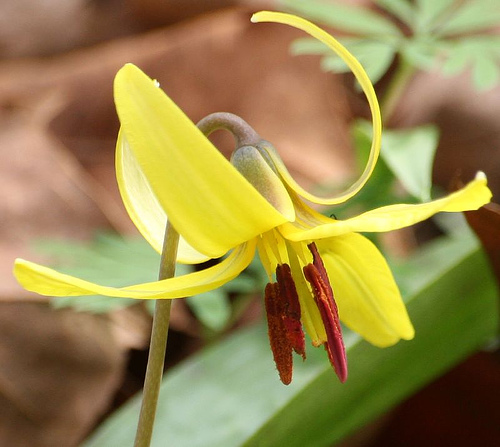
Erythronium americanum, yellow trout lily / Franklin County,
KY
(*photo
credit)
April 1, 2007 Palm Sunday and Foolishness
One of the worst forms of foolishness is to follow the crowd
through sheer emotion. Should we fault the ones who stood and
shouted, "Hosanna to the Son of David," because the Messiah was
coming to his own in a formal manner? A mere five days later would
not this same crowd shout, "Crucify him." Two very different
emotions directed at the same person! Maybe the foolishness is not
in what is said but in the shouting as a crowd. I must confess
that I was very uncomfortable while attending the University of
Texas, when the vast crowd of spectators would stand as the
football team entered and raise their right arms in the "longhorn
salute." Mass hysteria! But some dismissed my attitude as being
unsportsmanlike so I simply stayed away. I wonder what I would
have done if a youth in Germany at the time of Naziism? Would I
have saluted Hitler like the rest of my peers?
That brings us to what do we do with the crowd, and especially
in this age when the crowd is composed of the secular cultists of
our age? The secularists are all around us, vying for our time and
attention. They may take note when we refuse to shout, clap,
motion, or wave for the right team, the popular candidate, the
popular television personality. "Being with it" is part of total
acceptance. Loners are to be ostracized, demoted, looked down
upon, and marginalized. Who dares to be different in style of
clothes worn, in type of vehicles driven, in size of home owned,
and in what makes us one of the persons of glamour and attention?
But looking a little deeper, isn't this a form of foolishness and
are the participants not being as totally tricked on April Fool's
Day as anyone in our society?
This does not mean that we are to avoid all gatherings or to
avoid showing a certain emotion at a funeral or anniversary
gathering. It is more to seriously avoid the hysteria over such
events as the arrival of a celebrity or over crucial sporting
events. Today, developers are deliberately building stadiums with
boisterous cheering sections; they place shouting fans in specific
sections of a playing field or building; hooligans follow teams and
threaten athletes and police (one police officer recently died in
Italy). Ruling or participating through the power of such unruly
spectators shows the breakdown of civility and the democratic
process. It is court by the lynch mob and the agitation shown by
Middle East crowds with arms upraised and guns firing in the air.
What becomes evident in Holy Week is that the innocent suffer
from such demonstrations. Jesus did not want to be a king in the
worldly sense on Palm Sunday, and he certainly was not worthy of
conviction by a mob on Good Friday. But even the power of Rome
bent to the mob and Pilate washed his hands. What does this say?
Maybe that at a given moment a highly emotional crowd can have its
say. Let us all be more sensible and not get into such
circumstances in the first place. And let us all be demonstrative
but in a consoling fashion as companions of Jesus during this Holy
Week.

Bloodroot, Sanguinaria canadensis
(*photo credit)
April 2, 2007 Preached Retreats
Holy Week is generally an ideal time for retreats; the Pope
and his administrative staff have completed their annual retreat.
In the papal case it was a group or preached retreat consisting of
talks each day and time for private and communal prayer. That is
the most common form of spiritual retreat, and I have both "made"
such a retreat, especially during studies, and have "conducted"
dozens of them during my active ministry. Due to duties (weekends
are the ordinary time for such retreats) I have not be able to give
more than one a year in the 21st century. However, later this
month I will go to Oshkosh, Wisconsin, to "give" or conduct such a
mid-week retreat. It is important to keep primed for preaching and
to be connected with a variety of retreatants.
Many of the retreat purists would say that the real retreat is
the directed retreat. This consists of a one-on-one relationship
between a skilled spiritual director and a retreatant who meets the
director once a day and talks over the movements of the Spirit
during the prayer periods of the retreat. No doubt, a directed
retreat is ideal when major decisions are to be made about a change
of status or state of life.
A third type of retreat has been mentioned in previous
reflections: "retreat setting" (1/21/04); "retreat planning"
(1/3/05); "retreat cabin" (3/10/05); and "retreat in the woods"
(7/10/06). This private or personal type of retreat is a special
time set apart to talk matters over with God without the assistance
of a third party. This is more a special annual occurrence and can
be done in any quiet setting.
Preached retreats have immense value as special opportunities
for spiritual enlightenment. Some feel a deep need to get away, to
converse with God; they find value in a spiritual discourse and
formal prayer; they come to certain resolutions or possible
improvements during the coming year. In giving preached retreats
I strive to speak several times a day for half-hour intervals and
allow equal or more time for personal reflection. I do not give
retreats except where silence is the rule. I also offer posted
times for one-on-one conversations with the individual retreatants,
if they desire to come and visit.
These preached retreats differ from the other categories in
that they are conducted at retreat centers with regular meals and
lodging conditions; they have more formal prayer times, and the
centers are staffed by people who are willing to give special
spiritual direction as well, and who assist retreatants in a
variety of ways. Such centers and settings involve extensive
physical facilities and formal grounds that require considerable
resources to maintain. Thus those who operate the centers are
often hard pressed to meet expenses, and the normal recommended
donations exceed what some lower income people can afford. The
clientele is more selected even when the fees are not obligatory.
Obviously I am inclined to prefer less formal retreat settings.
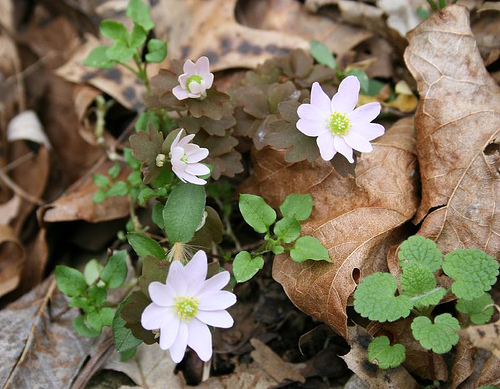
Rue anemone, Anemonella thalictroides
(*photo
credit)
April 3, 2007 Passover from Slavery to Freedom
Today is Passover for Jews and this week is "Holy Week" for
Christians. I once attended a Passover service in a home setting
with a Jewish friend and saw the closeness of the service to our
own Christian liturgical services. Our religious roots go way back
and Passover is the time we see this most vividly. At various
times, parishes celebrate the sacred remembrances in detail. What
all people whether Jewish, Christian, Moslem or other have in
common is the fundamental desire for freedom -- the passing from
some form of slavery to the freedom of the children of God. Isn't
that what this basic feast is all about along with thanks to the
marvels that God has done for us?
How does our world need liberation today? Let us recall a
few:
* from destitution -- Today 850
million people are hungry and
18,000 youngsters will die from starvation or deficiency in food
supplies. We have the materials; we have the ability to conquer
this hunger and yet we have not brought all forces to bear on
addressing the issue of hunger. We must be liberated from the
inability to act and save lives.
* from our selfishness -- As a global community we do not yet
have the willingness to come together as one people and live in
peace so that the urgent basic needs of people can be properly
addressed.
* from our diffidence -- We are hindered by our lack of
confidence that we can make a difference -- and this is a power
play by the super affluent to keep us all in our respective places.
When people finally realize that this Earth is spherical and that
we are never really distant from each other, we see that by working
together we can help liberate our brothers and sisters from want
and lack of basic needs.
* from concentration of wealth -- We often think each should
be able to have or consume as much of the world's wealth as the
military regimes under which he or she is privileged to live will
allow. The idea that massive accumulations of wealth are
acceptable should never be part of our political or religious
belief system. Why do we tolerate such inequalities except that we
feel bound by culture and custom to keep silent within the system?
* from false allurements -- We are captivated by the power of
the materialistic culture that overwhelms us on all sides. How can
we be free not to undergo the temptations that seem to cheapen our
lives and cause us to be slaves of matter?
* to act -- We are really free and have already passed over to
the atmosphere of freedom. Christians talk about the new life we
now live in Christ and that this is the beginning of our freedom to
change the world. We now are called to believe that what we
fundamentally are must be fully realized through deeds and actions.

Trillium sessile
(*photo
credit)
April 4, 2007 Spy Wednesday and Privacy Matters
Spying on another, whether that be Jesus or any one of us, is
an uncomfortable matter. Unfortunately, on this day we ought to
consider that the retention of our private property and space is
now being infringed upon in ways unimagined a short time ago. Part
of this is due to the sophistication and speed of computerized
information.
* Intrusion is all about us from spam to telemarketers, from
junk mail to loud advertisements. Our space is being violated to
such a degree that we hardly take notice anymore, and yet this
violation is changing our quality of life for the worse. We are
finger-printed; we have our financial rating whether we like it or
not; we are required to carry identification at most times in
public. Our cars are licensed and insured; our luggage is
searched; our shoeless feet are scanned, and we take all of this
for granted. Intrusion destroys our freedom even when it does not
exceed the limits of the law. Other practices are worse.
* Privacy theft is rampant, as people lose their credit
cards,
their right to a special social security number, or
banking deposit information. Our privacy is revealed in rather
strange ways. More and more cases of this appear each day along
with feeble attempts to keep basic information from the hands of
the general public. Credit cards and the use of ATM machines are
certainly convenient, but convenience involves inherent risks.
* Spying makes use of ever more sophisticated gadgets and
devices hidden in unexpected places from outer space to bedrooms
and work stations. Now parents, guardians, the police or anyone
can follow the whereabouts of travelers by inserting GPS devices in
vehicles; one can determine the exact location within feet of
where someone is at a given time. Other devices can photograph
travelers and customers virtually anywhere and can watch their
behavior as well as the speed at which they are driving -- even
automatically dispensing traffic tickets to violators.
Good name theft is quite possible in this age of almost total
openness. It is highly possible that someone (totally hidden) can
accuse another of virtually anything true or false and can insert
the accusation on the Worldwide Web for the whole world to see.
A conclusion is that we ought to take steps to avoid the
intrusion caused by such practices and devices. We could withdraw
from society and live as a hermit, but even hermitages can be
located, visited and photographed. We could keep to ourselves, but
social life demands more. Other than not revealing one's private
financial information, what more can be done? One advice is to do
nothing that one would be ashamed of before anyone, for what is
done in the dark is revealed in the light. But the other side is
that we need to accept the conditions of our world and "ride with
the tide" as the saying goes. Christ accepted the presence of a
spy and maybe that is part of our own current condition as well.

Bluegrass wildflowers
(*photo
credit)
April 5, 2007 Cranks Creek Survival Center
On Holy Thursday we commemorate the establishing by Jesus of
a priesthood to carry on his mission and the role of Jesus and all
of us as those who are willing to serve others. The very hallmark
of Christianity is service. This day offers an opportunity for us
to highlight a group that I have been associated with for thirty
years -- The Cranks Creek Survival Center (CCSC).
The CCSC was started by Becky and Bobby Simpson in 1977 in
Harlan County, Kentucky, near the Virginia border, in order to deal
with the impoverishment resulting from severe flooding caused by
surface mining and denuding of the surrounding hills. The services
rendered relied heavily on close knit family cooperation and help
from other neighbors and distant friends. The financial resources
were quite limited because Bobby had been partly blinded through
a mining accident. If one would say what keeps the Simpsons
operating for thirty years and giving assistance to thousands of
Kentucky and neighboring Virginia families, the answer is a sense
of trust in God that resources will arrive from friends and a
belief that one always helps another when in need.
The CCSC started as a center with environmental concerns but
moved to provide more social assistance when the everyday needs of
neighbors for improved housing, food and clothing were required.
When threatened with loss of money from a donor because the group
had edged away from pure environmentalism, Becky responded, " When
the land is in trouble, we fight for the land; when people are in
need, we help the people." That particular source of funding
ceased but CCSC was not allowing outsiders to dictate its
operational patterns or mission -- and it has stayed independent in
setting priorities over the entire span of its existence.
Personally, I have received a portion of my theological education
from these folks, as I have come to see the unity of eco-justice
and social justice issues.
Since the center's beginning, the Simpsons have transformed
their home as a support center for their neighbors. As word of
their ministry spread, more residents contacted them for help. In
return, literally thousands of volunteers (many of them are college
students) have come from different parts of America to offer
assistance. Amazingly, Bobby recognizes hundreds if not thousands
of voices on the phone even before the callers give their names
again. This personal touch has helped greatly to acquaint
outsiders with friendly people who are assisting others.
Each year the Center works to improve or build forty-five to
fifty new houses; distribute food, clothing, shoes and other basic
necessities; provide Thanksgiving meals; and at Christmas give
toys, food and blankets to over 1,200 families. The Center
operates solely on donations of money, materials and services.
To offer assistance contact:
Cranks Creek Survival Center, P.O. Box 32, Cranks, KY 40820
(606) 573-2812
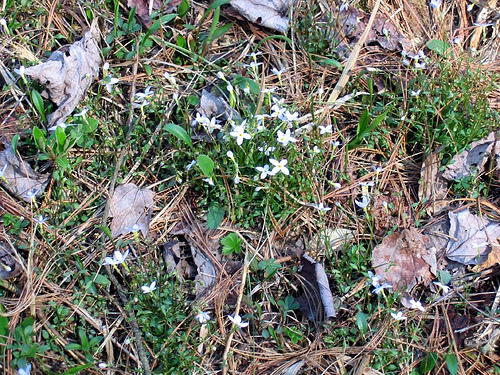
Hedyotis caerulea, Quaker's lady. Red River
Gorge, Kentucky
(*photo
credit)
April 6, 2007 The Spirituality of Suffering with Others
On Good Friday we focus on one event -- Calvary. Thus the
scene and the happening are not new, and our minds may return to
vivid crucifixes, pictures of Christ's suffering and death, or the
movie, The Passion of the Christ. I must confess I am unable
to
contemplate such scenes for long, yet I know people who are
excellent caregivers and joyful sufferers who have seen the movie
a number of times. Good Friday is mercifully short while the joy-
filled Easter season will span seven or more weeks.
But while mercifully short in duration, there is certainly a
spirituality of endurance and focusing on the Lord's suffering --
and we should welcome this way of acting and find here fruit for
our own journey of faith. To suffer with others is to show true
compassion and we start to recognize that this is inevitable as
loved ones suffer and die; ultimately we hope that others show
compassion for us when we are in such conditions. Suffering opens
itself to the sympathetic (that means compassionate) person. It
includes more than pity for that sentiment involves a certain
distance from the sufferer. Suffering with another means just that
-- we suffer because we are willing to be close to those who
suffer. It is more than just "do unto others as we would have them
do to us." It now becomes "be unto others, for we want them always
with us." That's the platinum plus rule.
But suffering with another can be emotionally draining. Some
caregivers seek to avoid this drain, but the involved co-sufferer
can find an energizing spiritual effect, which is unexpected. Good
Friday then is an invitation from Christ to us to go to Calvary,
but not to see this as entry into a past event as past, but as the
entry into a current event, made ever present in the Divine Liturgy
in which we participate. The ever-presence of Calvary makes the
crucifix a valuable sacred symbol. Through gazing on the crucifix
we become enlivened; we realize the suffering of the hospitalized,
the hospice patient, the imprisoned, the refugee, the abuse victim,
the one who is regarded as unforgiven. All of these are part of
the crucified and thus the lonely event on a wind-swept mound in
Jerusalem two thousand years ago becomes an ongoing global event.
But we are to do more than merely observe as though from a
distance, which is often all we can do on Good Friday itself. We
need to carry the message out and thus make our spirituality
something apostolic, for we are to tell the world that by entering
into the event as Jesus does, that is through a full sense of total
obedience to the Father, each of us takes on a role in the ongoing
salvation of the world. We enter with Jesus as other christs; we
are one with him in what he does and what he endures; we become
more able to undergo our own personal sufferings always in the
context of doing for others just as he endures suffering for us.
Thus the reality of our unworthiness gives way when fading guilt is
reenergized, as we become witnesses and apostles -- carrying a good
word as co-sufferers on our annual and daily Good Friday.
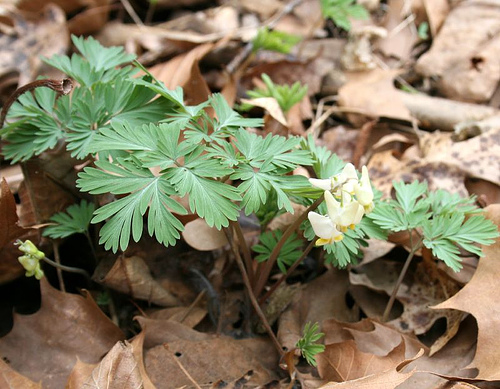
Dutchman's breeches, Dicentra cucullaria
(*photo
credit)
April 7, 2007 Global Health Is a Global Concern
As we reflect this day on the Lord in the tomb and await the
Easter event tomorrow, let us give a moment to consider the
collective health of the world, for this is also World Health Day.
On this day we reemphasize what has been said (see Daily
Reflections, April 7, 2005), that basic health is a right of all
people on the face of our Earth. We all know that, if a dozen
babies were dying somewhere in the United States without having
been given an easily accessible medical treatment, there would be
a massive expose and heads would roll. But if the same number die
under exactly the same circumstances in Africa, the news is greeted
with a yawn in this country. What makes the difference? Why are
we so concerned about our own people and so calloused about the
same possibilities -- and actualities in Africa? The simple fact
is that we see health needs and concerns differently in different
parts of the world.
We know there is a deeper problem involved. If we ensure the
basic rights of people in other lands, where will it stop, when
universal health care seems so unaffordable in our own country with
its escalating health bills and needs? At least a partial answer
is that we do not need to extend total access to the latest health-
related technologies; we could still save much human life
throughout the world at a relatively minor cost of $30 billion per
year (twelve days of the world's military budget). Such a fresh
outlay of financial resources could be used to include the
following:
* The World Health Organization
could expand inoculation
programs to cover every child in the world for all major vaccines
as well as adults susceptible to certain regional diseases. This
includes generic medicines for AIDS victims along with programs to
help prevent AIDS in hard-hit parts of Earth.
* Basic clinics and health services for all parts of the so-
called underdeveloped areas need to be constructed and provided
with equipment and refrigeration units for storing medicines. Part
of the funds should be used to train primary health providers who
could dispense certain medicines and vaccinate people. Assistance
for doctors and nurses to work in poverty areas could be given.
* Simple solutions for dysentery and malaria could be easily
provided. A simple plan to halt the killing by malaria of two
million African children a year would cost $10 per family. This
money would provide bed nets to needy families along with tips to
prevent malaria (at a total cost of three billion dollars).
Reference -- "The $10 Solution," Time, January 15, 2007.
Let us not forget on this World Health Day that many people
are trapped in conditions where they cannot get even the simplest
health treatment to improve the quality of their lives. We need to
be awakened from the tombs of personal concerns to rise to the
occasion. We must give new life to the poor who currently have
little or no access to basic health programs.
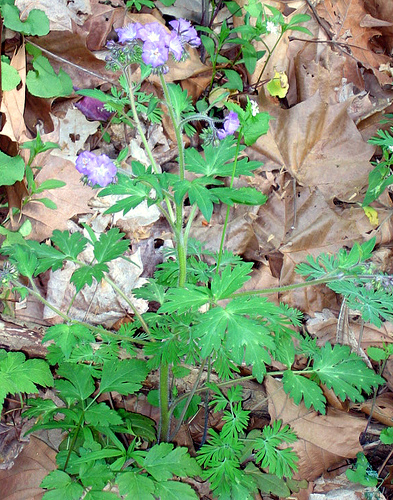
Phacelia bipinnatifida, purple phacelia. Bluegrass Kentucky
(*photo
credit)
April 8, 2007 Easter And New Life
You too must consider yourselves to be dead to sin but alive
for God in Christ Jesus. (Romans 6:11)
Easter means for us new life. It is the resurrected life of
Christ; it is the promise of resurrected life in each of us in the
future; it is the coming of spring and the new life of the world
all around us from wild flowers to bounding colts; it is the
completion of Lent and the renovated spiritual life within each of
us. Yes, we are people who are for life, affirming life and
enlivened. This life gives us joy and excitement, hope and victory
over death, peace and forgiveness -- the characteristics of this
new Easter season. The sorrow of Calvary is behind us; the
desolation of the grave has given way to the empty tomb; the
despair of defeat is transformed into the hope of ultimate victory;
the struggle and storm clouds now become the faint glimmers of a
lasting peace; and hatred and remorse give way to forgiveness.
Water has been blessed at the vigil and poured over the newly
baptized, those who experience new life in its spiritual fullness.
That water becomes the Easter water that we take and sprinkle on
the fields, the plants and animals around us. We bless because
blessings give new life, and we are God's instruments to bring new
life to others. The cleansing and the vital properties of water
make this all the more aware that we experience new life at this
time. What we are called to do is to carry that experience to
others so that new life will be extended to them as well.
The new fire of the Vigil and the paschal candle that we
blessed are additional symbols of new life. The darkness has now
been dispelled by light, and each of us is to help in the
enlightenment of this dark and troubled world. At dawn and during
the advancing Easter daytime, light fills our world and we cannot
contain the joy that we have. Just as we are bearers of water, so
we are bearers of the fire of Christ's love to others.
Eggs are also an Easter symbol of new life that will soon
hatch
from the shell and appear to all the world around us. Thus there
is the custom of Easter egg hunts and colored eggs. Perhaps the
new chick is a special reminder of this new life as are the rabbits
that are pictured in the marketing of Easter today.
All these and other new life symbols remind us that there is
something profoundly physical as well as spiritual about Easter.
We are called to celebrate because we are more than spectators; we
receive new life -- eternal life -- and this gives us the sense of
joy, victory, hope, peace and forgiveness. It is the promise of
joining Jesus who is now Lord in glory. Thus the added
characteristic is that now we have a glorious future ahead of us,
a future filled with unending joy. And this foreshadowing of new
life is what Easter is all about. We become energized in our
serious work ahead in bringing peace to a troubled world, with the
promise that there are better things to come.

Squirrel corn, Dicentra canadensis
(*photo
credit)
April 9, 2007 Garden & Library Week
It is good to have weeks dedicated to various themes for they
give us special topics on which to focus. April is an ideal time
to think "outdoors," and so gardens are very much in season. But
we need not neglect the indoors either for there are night times
and periods of showers when we find shelter and so the emphasis is
also on libraries. Can these two topics be coordinated?
Much of the garden experience has been written down over the
years and quite a bit of this wisdom is available in our libraries.
Browsing in the garden section (if this library area is wanting,
make this known to the librarian) will lead to several good books
telling about the successes and mistakes with the growing of
various vegetables and herbs and the use of certain garden
supplies. Often an hour in the library spares much heartache
during the gardening season. The beginning of this season is the
perfect time to acquire added pointers and suggestions -- and we
can all use more.
A difficulty is acquiring too many details, for we all suffer
from information overload. That can be controlled by knowing
precisely what one is looking for in the library, but allowing
oneself just a little additional free time to search about for new
attractions. Thus what is gained is a limited amount of knowledge
that can be stored in the useful section of the brain.
The fact is that ingenious ways are out there for gardening
with limited space, companion planting, seasonal species, and
special geographic locations, and on and on. New knowledge may
nudge us to try something that we know little about -- or stop us
in our tracks because of some unexpected limitation. Yes, book
knowledge is quite compatible with gardening -- and that explains
the popularity of periodicals such as "Organic Gardening."
Is the Internet replacing the library? Obviously for those
with computers the Internet is at least a partial replacement;
Google gets us to many sources we would never have heard of
otherwise. Some of these are books and information not in our
local libraries and the speed of identifying and assessing them is
truly amazing. The Internet is letting "our fingers do the
walking," which saves travel time. More and more information is
becoming available with each passing year.
Having said this, we must put in a special word for libraries,
especially useful when we desire to do a more thorough search on a
given subject. Seldom do ordinary gardening projects require
library research. If one is giving a talk on gardening and needs
to check out some research facts, the library is the ideal place to
go. Superficiality affects us all, and gardeners are not immune.
There are times for everything under heaven -- and, yes, there are
times to browse and search in the library. Libraries are treasures
of available information and worth supporting for the good of the
community -- and that includes gardeners of all shades and levels.
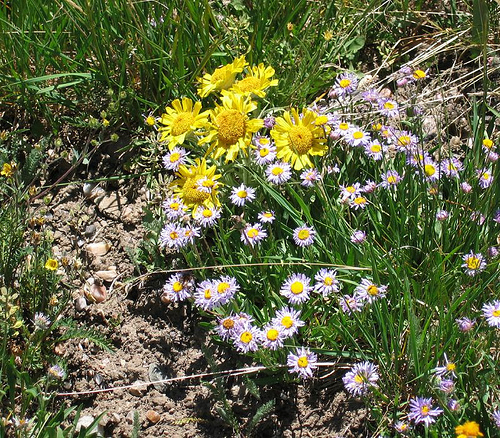
Alpine bouquet. Medicine Bow National Forest, Wyoming
(*photo
credit)
April 10, 2007 International Polar Year
An ambitious international, cooperative scientific endeavor
has been launched this year targeting research on the polar
regions. This involves about 50,000 people in 300 projects from
dozens of countries at a cost of 1.3 billion dollars. The area of
scientific research is wide ranging, from the effects of climatic
change on human beings in polar regions, through the effects on
flora and fauna, to the melting of glaciers, ice caps, and sea ice.
What is evident is that much more needs to be known about what
is happening in the North and South Pole regions. Some predict
that the sea will be ice-free in summer in the northern region in
just a few years. But predictions are always hedged because the
unknown with regard to the effects of greenhouse gases on climate
moderation is immense. Weather always tends to vary and so there
is no concretely predictable pattern but rather a variable one to
study. But definitely there have been trends in the past half
century, trends that tend to show a dramatic shift to warmer
weather. If these trends continue and the major ice caps (and not
just the sea ice) start to melt at an accelerating pace, then ocean
levels will rise and seacoasts will be inundated. Predictions
range from less than a meter to tens of meters provided the
Antarctica is as highly affected as are the northern polar regions.
The scientific work of this International Polar Year should
give a somewhat clearer picture of what has been happening in
recent years. The polar regions (especially native animals such as
polar bears) are like the canary in the mine. The condition of the
polar ice (accumulated over thousands of years) can be determined.
to a needed and better degree. If the indicators of warming are
correct and the caps are disappearing, the entire planet's health
is at stake. Ocean currents, ice accumulation and movement, and
the biotic life that occurs in these frigid regions are open for
fresh investigation and discovery. In some ways the polar regions
and ice are the final regions of our planet in need of exploration.
Investigation in such harsh conditions is difficult enough.
Team work is crucial. In the past, joint exploratory works were
successful after initial individual competitive efforts at reaching
places and enduring trying conditions. Knowing a region requires
more than just that beginning heroic feat; in-depth scientific
results requires immense effort on the part of many working
together. The fate of our Earth requires that we know as much as
we can in these troubling times, and to do so as quickly as massive
international cooperate works will allow. And this establishing of
the prognosis and the beginnings of a healing process is what the
International Polar Year is all about. Let's hope that this polar
knowledge advances rapidly; let's hope the template of
international cooperative scientific efforts will extend to other
human and planetary needs; and let's hope we are able to achieve a
better understanding of how we can use global resources properly
without damaging our fragile Earth.
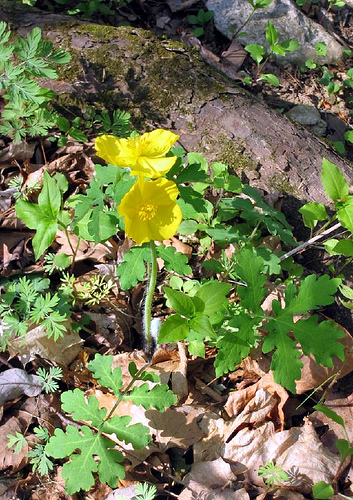
Celandine wood poppy, Stylophorum diphyllum
(*photo
credit)
April 11, 2007 Eighteen Seconds to Change the World
Eighteen seconds is the time it takes to change a light bulb.
We need to address the global warming problem, and one approach is
to use fewer resources. Some suggest that if each of us changes
one incandescent bulb to a compact fluorescent (CF) today, and does
this once a month for six months, the reduction in electric demand
would be so great that no new powerplants would be needed for a few
years. And we would be well launched on the road to breaking our
wasteful energy practices. Walmart hopes to sell one hundred
million CFs this year and it is quite possible that a few states
will outlaw the incandescent bulb as is being done in Australia --
but after the industry can meet this immense increase in demand.
Actually, acquiring a conservation ethic takes more than
eighteen seconds and we should not think everything will be solved
so quickly. We could reduce energy-wasteful auto trips, or reduce
airplane flights, or moderate heating and cooling of buildings.
And the conservation list goes on and on. The good part of CF
installment is that it launches so many people on the road to
realizing that their personal actions impact the greater world and
that a bit of the melting of ice caps is caused by the carbon
dioxide and other gas emissions related to our lifestyles. Our way
of living impacts the people on Pacific Isle nations and Bangladesh
who are threatened with inundation through ice cap melting. The
possibly thirty million flooded-out people in the latter nation
will have little place to move in a few decades, and the suffering
of these impoverished people will be immense.
What we are looking for is a change of attitude on the part of
many. Let's hope it becomes fashionable to conserve just as it has
become fashionable to refrain from wearing furs due to the
protestations of the animal rights people. Fashion changes require
a change in mental attitude and that could occur with an eighteen
second or less decision to use fewer resources. Therefore the
light bulb change is at best an exercise that sets us on the road
to further changes that will profoundly affect the manner in which
we treat our fragile Earth.
An added remark on brief investments of time and resources.
We need to take eighteen minutes and write to ask legislators to
make some changes necessary to put our nation on the road to a
conservation ethic. Perhaps if enough people do this, we will make
a difference, and excessive energy use will be curtailed to some
degree. The change of attitudes takes more than three hundred
million people changing bulbs; it requires that our elected
representatives see that wider ranging actions such as advanced
automobile energy efficiency standards and improved public
transportation systems could have even more impact. Changing light
bulbs may change the economic picture and social practices of our
people to some degree -- but nothing like to the extent needed to
change the global warming effects on certain people in inundated
areas of the world. Maybe we need to invest a little more than
eighteen seconds in this problem, but at least let's start.
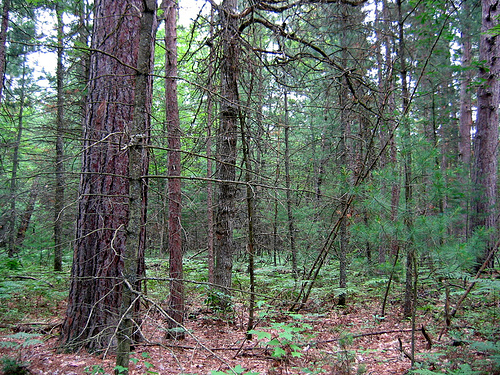
Red Pine Natural Area, Roscommon Michigan, old growth
(*photo
credit)
April 12, 2007 The Red River Gorge
A portion of the Red River Gorge or the Clifty Wilderness area
in eastern Kentucky is within our parish boundaries and contains
some of Kentucky's best scenic areas (see August 10, 2006 for
"Kentucky's Natural Bridge"). And this is where I perform my
annual retreat. One cannot help but being enthralled by the unique
natural phenomenon created from water and wind over millions of
years as part of the divine art work. In fact, this area contains
the largest collection of arches and rock shelters east of the
Rocky Mountains. The Red River is Kentucky's only designated
National Wild and Scenic River.
The Native American peoples hunted in these areas and Daniel
Boone camped there. In the 19th century these became sources of
iron ore (a number of early smelters/furnaces are located here),
saltpeter for gunpowder in wars from 1812 to the Civil War, and
timber. In the 20th century, with ownership and management by the
U.S. Forest Service, raw material extraction pretty much ceased.
However, another threat to the beautiful and pristine rocky areas
of the valley occurred when the sites were discovered by hikers,
campers and rock climbers. For a period of time the visitor volume
grew, and the lack of proper care and toilet facilities had a
noticeable impact on the gorge. People would drink alcoholic
beverages and scatter garbage, and each year one or more would
wander off and fall from the abrupt cliff lines. I know one person
who was permanently injured by a rock thrown by another while he
camped in the gorge under a cliff.
Citizens and the Forest Service personnel became aware of
damage being done to this region. Trees were cut for firewood,
trash was abandoned, climbing spikes were left on cliff faces, and
rock shelters were defaced. Noticeable damage began to appear even
though the areas have many miles of trails and camping sites. So
now in the 21st-century stricter rules have been imposed and the
areas have toilet facilities, approved climbing and hiking areas,
a ban on camping less than 100 feet from the base of the cliffs,
and refusal to allow camping in the rock shelters. Modest camping
and parking fees are now collected; all garbage and leftovers must
be packed out of the area; excessive noises are forbidden; and the
area is being policed during the tourist season.
For more information you may wish to contact:
District Ranger, Stanton
705 West College Ave.
Stanton, KY 40308
(606) 663-2852
Reference: "Kentucky's Land of the Arches,"
by Robert H. Ruchhoft.

Vinca minor, periwinkle. The old Millville distillery,
near Versailles, KY
(*photo
credit)
April 13, 2007 Thomas Jefferson: Patriotic and/or
Enigmatic
I have read much on the life and work of Thomas Jefferson, our
third president. The more I read the harder his life seems to
understand. Certainly he was brilliant and possessed many gifts --
writing talent, political skills, architectural creativity,
agricultural expertise, appreciation of foreign languages and
literature, love of music, culinary tastes, knowledge about
construction, and sheer inventiveness. This is evident to anyone
privileged to visit his Monticello homestead. Jefferson was a man
both of his times and ahead of his times. He was not perfect, but
his love of his family was certainly a plus, though the Hemmings
affairs makes us draw back a little. And yet we find a sense of
mercy working in his life even if all the rumors were partly true.
His relationship to various slaves and Afro-Americans was somewhat
ambivalent, and we simply do not know how he resolved the slavery
question in his own mind. He seemed to tolerate a cultural
condition that he personally did not like. That ambiguity extended
into his economic affairs, for he was a man of fine wines and
furnishings and yet his finances were in disarray.
Jefferson had a vision. He seemed to want the citizens of
this nation to work together and grow (certainly the Louisiana
Purchase during his administration was the largest addition in
territory ever witnessed by the United States). He sponsored the
Lewis and Clark expedition that gave our country ultimate title to
the northwestern areas. His vision was of national growth and yet
also of states rights and local homesteading -- a simultaneous
emphasis on several levels. He wanted us to be one people.
We can always find weaknesses if we look hard enough and long
enough. Jefferson was a revolutionary and yet once the fighting
started, Jefferson's Revolutionary War contributions were hazy at
best, especially while serving as Virginia's governor. I'm unsure
I would like to have met and talked with him. I suspect that he
was aristocratic, haughty, biased against formal religion and most
likely would not have even spoken to my Jesuit brothers had he met
them when the Society was resuscitated in the early 19th century.
It is uncertain what he really held in relation to Native Americans
and whether his concerns would have changed over time. Where would
he have stood during the Civil War? How would he have adjusted to
later waves of immigration or to the rise of the corporation and
major money interests? Knowing what we know, we would all have
been in for some surprises when it comes to Thomas Jefferson.
Having said all these things, the more I read about the mixed
backgrounds of our forty some American presidents, the more I am
inclined to place Jefferson in the top ranking and hold him in
highest esteem. I most likely would have voted for him for
president, granted all the differences in political procedures at
that time. But we must remember, we did not live then, and he died
in 1826 on the fiftieth anniversary of the Declaration of
Independence -- and that was a mighty document from his own pen.
However, the Jeffersonian spirit continues to this day.

Yellow violets, Red River Gorge, KY
(*photo
credit)
April 14, 2007 Global Warming Day
-- 1,200th Daily Reflection --
Various public interest individuals have suggested that today
is a good day to think more seriously about the global warming
phenomenon that we all hear so much about these days. There should
be a teach-in about what is coming, but I am unsure that this is
wise since most know that drastic consequences will occur if our
Earth gets even warmer. So the day should be more. How about
doing something about global warming at various levels?
Individual -- Develop a conservation ethic (see the
conservation section of the websites table of contents). We need
to convince both ourselves and those around us about the need for
conservation. A one-on-one interaction will have an effect once
the awareness begins to spread, -- and it is doing just that. The
grassroots is our starting point.
Local community -- The conservation ethic can be extended to
civic, school, church, and business advocacy. Speak up about
wasteful practices and get others to back a joint public expression
so that it is more than one individual's idea. There is great
opportunity to bring out the concerns of more people and these
concerns will have a feedback effect on local civic practices.
Regional and state groups -- Let's direct attention to
political leaders for often these can take a leadership role in
starting something that can expand quickly to other states and
regions. Besides, national businesses and others find state-by-
state regulations to be quite onerous; they may be the ones who
seek to move these practices to the national levels for the sake of
uniformity and convenience.
National policies -- The time for actions to become national
in scope is long overdue. Pressure on national decision-makers of
all political shades is needed right now and so letter writing,
lobbying, and discussions on global warming matters are all options
for the concerned citizen. New national policies that endorse
conservation and support of wind and solar energy alternatives will
go a long way, as will mandatory automotive fuel efficiency
standards. These standards should be extended to maritime and air
traffic vehicles as well. The national government could do much
more and legislators at all political shades are starting to
understand this.
Americans are known to have little concern about global
warming problems whereas in other countries the matters are taken
seriously. Why? Various reasons are given. The leaders of our
country are not yet convinced that to confront this issue head-on
demands a radical change in our way of operating; they fear a
possible change in our political and economic structures, and a
reclaiming of the commons now captured by exploiters. Today we
must couple an individual, local, regional and national
conservation ethic with the movements of people in other lands, for
global warming is a global concern. Let's help make it so.

Erythronium albidum, trout lily. Bluegrass,
Kentucky
(*photo
credit)
April 15, 2007 From Doubt to Faith
Doubt no longer but believe. (John 20:27)
The readings continue this year's theme of new life, and the
characteristics associated with the rich mystery of Easter. Today
we discover a special Easter theme -- faith. The story tells of
the affirmation of the Apostles who see the resurrected Christ and
the doubts of Thomas who was not present at the first Easter event.
Thomas insists on having empirical evidence that new life is
occurring, and then this leads to his moment of faith.
The week after Easter allows for us the initial joy of Easter
to wear down a little for us. We are still confronted with the
troubled world in which we live. The question is what can we do
about it? Can this Earth be made whole again? Can we bring about
new life, or is the planet doomed to deterioration, to melted ice
caps and flooded coastal areas, to hurricanes of immense magnitude
and extremes of heat and drought? Does Calvary envelop our Earth
and are we to blame? Can we hope to "bite the bullet," and take
remedial action? Can we check the expanding terrorism that is
touching people in various lands? Or is our culture as we know it
threatened?
We have choices. We may choose life or death. Those without
a sense of Resurrection often enter the groove of despair and fail
to choose life. They see no hope and simply live for themselves
with the few years left, self-centered and walled in with the
conveniences that can be salvaged. They seek to avoid the
terrorism or the sights of crucified Earth, denying the facts,
excusing themselves, or escaping to material enticements.
We are for a choice that is pro-life. We cannot refuse to
choose for that brings about the death of our planet and our
civilization. Rather, for people wrapped in the Resurrection
mystery we choose life in its fullness. We cannot afford to doubt,
even when we doubt that we will succeed in doing what must be done.
Certainly, we see that current conditions are unsustainable for
they will bring about the death of the planet and our civilization.
Stop! We are empowered in the resurrected Lord; we recognize
our own powerlessness, but we also know through faith that we have
a divine power to overcome the downward spiral of our materialistic
culture. We can attain something new and it will be of a higher
quality, a better world, a new life. We do not fully see what is
to be the outcome, but we know in the fullness of the resurrection
that people can unite; they can support a United Nations; they
can work together on joint peace making projects; they can know
that renewable energy and conservation will and does work with high
quality life; they can realize that the scars of Earth can be
transformed; they can know that social justice to all will quiet
the terrorist tendencies of a few. We believe that the world, with
God's help, can be a better place. We have faith in the "can do"
for this is Christ's lordship extending itself to us. Yes, we can.
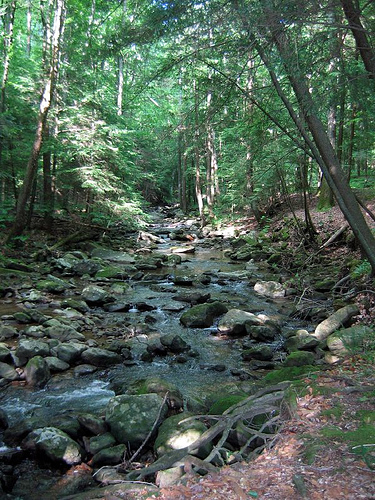
Appalachian stream, eastern Tennessee
(*photo
credit)
April 16, 2007 Keeping the Earth Beautiful
This is Keep America Beautiful Week and yet we know that this
characteristic of beauty is not to be limited to our fair land but
to the entire Earth. So really the focus should be on a broader
mandate, for all people admire and are enlivened by natural beauty
in all its created forms -- ocean shores, majestic mountains,
tranquil lakes, rushing rivers, flora and fauna. In addition to
the natural beauty that we observe and experience in many ways, are
also the places wherein human beings have enhanced that beauty
through prudent landscaping, ingenuity and work.
Landscape disturbance occurs in a variety of ways, sometimes
out of selfishness and other times in the guise of giving
employment to workers or extracting useful products. The sight of
devastation caused by clearcutting or mining a land for resources
with no thought of meaningful reclamation is the very opposite of
the natural beauty that refreshes our souls. In order to cope with
this human-caused ugliness, some folks close their eyes and refuse
to observe the remaining natural beauty. This manifests the
insensitivity of a dysfunctional society and leads those who are
wealthy to take any means to find the remaining beauty spots on
this planet. The pinnacle of this conduct is when a developer
builds a hilltop mansion so that the owner can observe untouched
beauty, whereas others who observe the total scenic view see the
mansion as a disturbance -- which it really is.
What must we do given the current situation? Primitive scenes
and undisturbed natural beauty are becoming less and less a reality
so we should consider approaches while attempting to halt future
mass disturbance. Some solutions we can support include:
reclaiming the devastated landscape through a host of remedial
practices: removing billboards and advertisements that mar the
landscape; halting clearcutting of forestlands and abiding by
better harvesting practices that conserve the natural beauty of
existing forests; stopping extraction of coal in elevated
landscapes and using immediate methods of reclaiming top soil in
level surface mining areas in the West; curbing scattered
developments in undisturbed tracts of land and limiting new
construction to existing developments; ensuring that leasing of
public lands occurs only after strict environmental assessment; and
educating the public on the aesthetic and even economic value
(tourist potential) of undisturbed lands.
In a society sated with consumer products and their
deleterious effects, treasuring natural beauty is something that
must be reemphasized. Providing experiences of nature would be a
valuable long-term investment in our country. All young people
should have an opportunity to visit and observe areas of natural
beauty, with a formal educational program pertaining to native
flora and fauna so that they come to appreciate the immense natural
beauty all around them. Essays, paintings, and projects dealing
with such beauty should be encouraged.
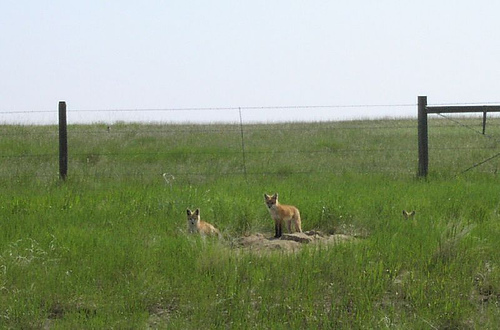
Red fox family (near den) / Montana
(*photo
credit)
April 17, 2007 The Red Fox
My attitude about red foxes (Vulpes vulpes) has changed
immensely over time. When a youngster, we came to despise the fox
for its sneaky way of entering the chicken area and stealing a
plump chicken for its meal and that of its offspring. Foxes at
that time had an uncanny ability to know where the fowl were
located and could hunt down and kill a surprisingly large number
over time. They were marked by farmers for extermination. So we
were both blessed and perplexed by the presence of this quite
graceful animal in our locality. Thus, like the crow, the red fox
was also on our list for open season hunting. I vividly remember
the exact location of a playful group of three or more fox pups.
We were across a small creek from the den and they were unmindful
of our presence. Even just after the resounding volley we sent
that killed them, the mistake was before me, then and now. Hunting
wildlife was part of my life where ambivalence reigned supreme, and
it is not relieved by supporting the presence of red foxes today.
The saving grace today for the red fox is that the orangish-
red fur is no longer valued so highly, for women especially do not
find wearing furs to be very fashionable. Animal rights people are
poised with paint cans to add to the unfashionableness. Today,
much of the fox niche has been filled by the more aggressive coyote
-- that carries some of the same onus that the fox of yesteryear
did. Although literature has never been easy on the fox for its
trickery and conniving reputation, we still need to give a place
for this native mammal. In fact, foxes thrive in a rather
developed countryside by being highly nocturnal, by being omnivores
(with an appetite for everything from berries and fruits, to
grasshoppers and squirrels), by an ability to hear the movement of
small animals under the snow or leaves, by large spring litters (up
to ten pups), and by a wide span of native territory (the red fox
is in much of the continental United States and Canada, throughout
much of Europe and Asia and has even been introduced to Australia).
The fox is resourceful and, where possible, uses dens abandoned by
other varmints instead of making its own. The male assists in food
gathering. The pups are often brought live prey to play with and
learn the process of hunting and killing.
One of the aspects of the red fox that could still make it
somewhat valuable is its bushy tail, which has been prized as a
souvenir by an assortment of people of various ages. That tail is
certainly pronounced and makes a display item for some people. But
all things considered, the red fox is making a come-back in our
part of the world, and thank heavens. There is a gracefulness that
is present when we see foxes tracking back and forth across the
countryside, covering the scent of the tracks by special maneuvers.
I think my own change of attitude with regard to the fox is really
a possible template for what others in our society should do. The
art is not in the pleasure of hunting these animals but in
preserving and appreciating their presence. Wildlife deserves to
flourish and we should take pleasure in its presence.
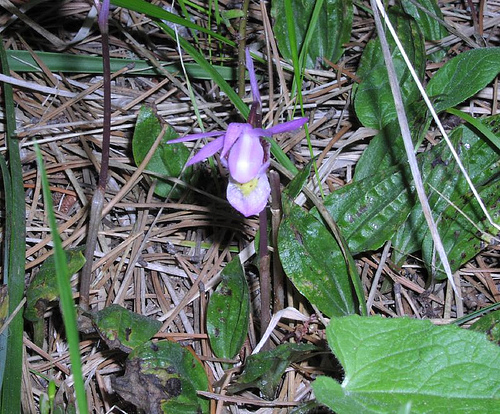
Calypso bulbosa, Calypso orchid / Cypress Hills
Interprovincial Park, Canada
(*photo
credit)
April 18, 2007 All Have the Right to Employment
I have always enjoyed working and knowing that what I am doing
can make some difference in this world. Isn't this a basic
aspiration of all people, something that we wonder about
exceedingly on this Third World Day? We know there are millions of
under- or unemployed and that these numbers are rising each year,
but should they? Couldn't something be done? No one should be
subjected to longer-term unemployment, especially when citizens
desire to work and make their own livelihood. The basic right to
earn a livelihood is guaranteed by the governments and ultimately
by the United Nations. Some may say, "Work opportunities do not
exist." Instead, the work is available, but the financial
resources to pay for the work are not forthcoming. To make this
basic right operative requires a radical readjustment of the
economic system, a redistribution of the wealth of this world. Why
should a privileged few receive high salaries when others do not
have enough to live on? Governments are the employer of last
resort, a philosophy behind the Great Depression's Works Progress
Administration (WPA) -- and this is still a valid principle.
Unemployment varies considerably from country to country.
In some nations the un- or underemployment reaches unusually high
rates of two-thirds of all workers. Many underdeveloped nations
find it increasingly difficult to create jobs fast enough to meet
their rapidly swelling labor force. Due to automation, the labor
force in many sectors (e.g. coal mining, agriculture, and
railroading) is in decline and makes the employment picture all the
more challenging. The hopelessness found among long-term
unemployed workers, leads to family and community discord,
substance abuse, and acts of violence. A society that says that
the workers, even when willing, are unneeded is lying.
Discovering and promoting meaningful work positions are duties
of the government -- the ultimate employer. No one can deny that
much has to be done in this troubled world. There is far more work
to be done than people to do it. Matching work opportunities with
workers becomes a challenge. Here the taxes on the wealthy could
be directly shunted to open up fulfilling work opportunities for
the unemployed -- a direct reclamation of the common arena of work.
How much discontent on this Earth is due to lack of work.
Employment in a number of areas could answer the deep cause of
social unrest. The following are job opportunity areas:
* Support for small food producers;
* Provision of potable water systems for all;
* Design and construction of adequate housing;
* Support for public health and sanitation facilities;
* Construction and maintenance of schools;
* Construction of recreational facilities and other
infrastructure such as transportation and communications;
* Environmental protection education, promotion of renewable
energy programs, and reforestation projects;
* Care for the elderly, infirm and orphans.

Bernheim Arboretum. Bullitt Co., KY
(*photo
credit)
April 19, 2007 Compensating the Home Care-Giver
What are the types of job opportunities that must be created?
In some ways the most obvious are the jobs being done that go
unpaid and yet are deserving of a living wage. Perhaps tens or
hundreds of millions of people are home-bound due to old age or
some type of disability. Caring for them is something that
requires the utmost services of individual care-givers, many of
whom are family members who receive no compensation for actual work
given out of love and loyalty. We are not asking that these be
richly rewarded in a monetary manner, but some payment could help
them and thus spare them the necessity of going out and earning in
other ways. Even quite modest funds to these caregivers (below
minimum wages) could go a long way.
The focus of attention here is on the unheralded people who
take care of the elderly, the disabled, orphans and other
dependents. We speak mostly of women who spend a fair portion of
their time at home giving much attention to these less fortunate
relatives. Those who need constant care consume the dedication and
attention of at least one out of every twenty people on the face of
our Earth. We are talking about over three hundred million
caregivers. This figure is not invented; in most cases caregiving
becomes a full time occupation and also saves society by preventing
institutionalization of the people being cared for, which would
cost far more than would be required here.
The common good demands that some take care of those who can
no longer care for themselves. A bond of love and responsibility
motivates those who take care of the invalid or elderly who require
assisted living or total care. Ireland is one country that gives
compensation for caring for the elderly at home. In recent times
when people worked at external occupations, the more able-bodied
became unavailable to assist those who were dependent within the
extended family. Thus senior citizen facilities arose even for
those who are given only assisted living. The willingness on the
part of loved ones to sacrifice for those in need is not a reason
to exclude them from the "commons" of tax benefits.
Many social welfare systems in the developed world give some
or total compensation for assisted living and totally-dependent-
care living conditions. These can amount to tens of thousands of
dollars a year per person and can be paid for either from existing
estates of the individual or from the social welfare funds of the
state. When people are able to live at home under compensated
caregiving, they feel far less institutionalized and the
compensation stays local. Furthermore there is no need for the
caregiver to have to seek a non-domestic occupation. A health
care oversight committee could actually engage in home visits to
ensure that the caregiver is performing the duties along proper
guidelines. But this is not beyond reasonable expectations. Every
person saved from institutional care should be receiving quality
care in their final years.
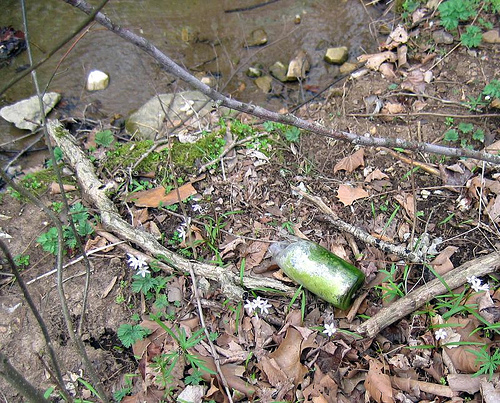
Found by the stream, nature-made terrarium inside broken bottle /
Woodford County, KY
(*photo
credit)
April 20, 2007 Earth Day Evolving
We are all broken bottles, which contain the vitality for new
life and beauty. That is what resurrection is all about, and so we
look out to becoming renewed and better. For the past thirty-seven
years we have given a special focus in April to Earth concerns --
healing, enhancing, preserving, protecting and promoting our
fragile and precious planet. It has been a long time since the
heady days of that first Earth Day in 1970, when the issues seemed
so easily solvable and the solutions so easy to implement. No,
some pollution problems have been solved (air, water, lead and
mercury pollution), but we are confronted with global warming,
something not envisioned in 1970. But the state of affairs is
definitely becoming clearer, and maybe that is reflected in
rereading the April essays for the past three years. Urgency to
act grows, and more and more people are starting to take notice.
Certainly the times they are "achangin'." We are now
confronted by the frightening aspects of uncontrolled
globalization, the widespread effects of terrorism on innocent
people, and the anticipated effects of global warming such as
melting ice caps and rising oceans. A scientific consensus is
rapidly emerging -- and that is a heartening effect. Even
Walmart's resolution to sell one hundred million fluorescent light
bulbs to enhance energy conservation is a speck of good news.
However, two aspects of the emerging solutions are worth
noting. The first is that many of the environmental groups are
becoming too cozy with the moneyed interests and have lost their
initial sheen by arguing for soft approaches to environmental
problems (new nuclear power plants and more and more ethanol plants
for biofuel by using our nation's limited corn supply). The second
is the emerging understanding that the environmental solutions rest
on a radical change in our economic/political system that
emphasizes sharing resources among all on Earth and addressing the
basic needs of people and especially the destitute. Eco-justice
and social justice are one and the same.
The critical nature of this Earth Day is one of major
decision-making for the time is now. We do not have the time to
relax or the option to act like green advocates. We must make some
major decisions at this moment and see just how important the work
we have is. The answers are both emerging and frightening. We
are called to take on this task of saving our Earth with far more
seriousness and urgency than was seen in the earlier portion of the
Earth Day series. We know more and we include more people. But
the part that is most frightening is that the willingness declines
as consumerism in its materialistic forms creeps into the lives of
Chinese, Indians and others who acquire some of the goods that have
so allured the western world. Thus the willingness to change is
becoming more difficult for some -- and governments are not always
willing to impose restrictions on their people. See Special Issues
on this website with Fifty Ways to Reclaim the Commons.
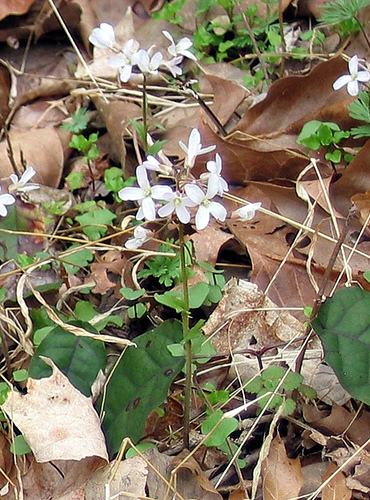
Cardamine douglassii, purple cress
(*photo
credit)
April 21, 2007 Revelation and Earth Day
Then I heard all the living things in creation -- everything
that lives in the air, and on the ground, and under the ground, and
in the sea, crying, "to the One who is sitting on the throne and to
the Lamb, be all praise, honor, glory and power, for ever and
ever." (Revelation 5:13-14)
So often we focus on Sunday Gospel narratives, but we need to
find occasionally that the Easter characteristics are found in the
companion readings as well. Since tomorrow is Earth Day, it is a
time to turn to the book of Revelation, for it gives us the sense
not of doom but of ultimate glory.
This is especially important today because we are all becoming
aware that our Earth is in trouble and suffers from possible
profound climatic change due to excessive amounts of greenhouse
gases -- and these result because of our lifestyles. Furthermore,
the terrorism that is expressed by those in the Middle East is
especially disconcerting for how does one reason with people of
such ilk? Thus global warming and terrorism confront those who
seek to celebrate this Earth Day -- if celebration is possible.
What the Christian must reaffirm is that we can celebrate; we can
have joy for beyond the Apocalypse that seems so apparent, there is
a future that includes a New Heaven and New Earth. Our Earth Day
must be celebrated because this is the precursor of what is to come
in the future.
We note that the above text (Revelation 5: 13-14) actually
makes a special effort to include all creation in land, air and
water voicing praise. Of course, the wording is figurative for
nature cannot speak. But Earth smiles and Earth expresses herself
in special ways. So the creatures on Earth are part of this
expression. What must be celebrated on Earth Day is the praise
that comes forth to God from all creation. All is a blessing and
all give blessing. The more we enhance, support and give new life
to Earth's creatures, the greater that praise is to God. We praise
both in our own speaking and also in our action, for in protecting
and enhancing Earth's creatures, we participate all the more in our
prayer of praise. The entire environment as we know it participates
in the celebration. This participation is truly a revelation! It
is more than being human; it is human enhancing and yet includes
all of creation.
The Lamb is now spiritually empowered and we are with him, we
humans and all creation. This emerging glory is within our vision
on this Earth Day. We go beyond the doom that seems so apparent;
we offer a vision of a future promise, a newness of life that
includes all human beings as well as other inhabitants on this
Earth. Thus the worth of creation is not simply something
transitory; we now enter with our cherished companions in the
emerging praise of God. Thus we must help overcome the damaging
human actions that threaten our environment and our culture. This
Earth Day is hopeful that we respond well to our calling.
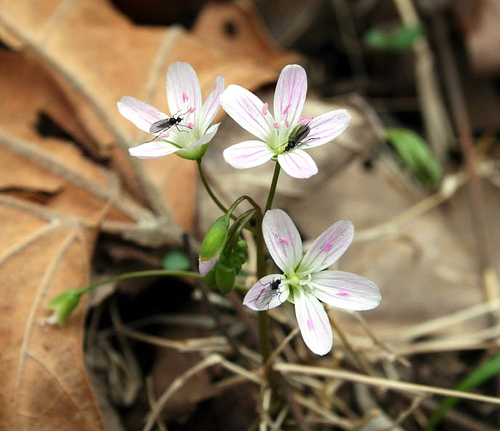
Spring beauty, Claytonia virginica
(*photo
credit)
April 22, 2007 Immigration Reform and Workers' Rights
What have you done to your brother? (Genesis 4:9)
The disciples had gone through a traumatic experience in the
suffering, death and resurrection of Jesus. They were simple souls
and so they resorted to what they knew best --fishing. It was
their traditional livelihood, and so the activity came naturally in
time of great stress. And Jesus came to them in a simple way to
assist them in their work-- for he had grown up a simple
carpenter's assistant. We need to be like Jesus and talk about
reforms that affect millions of the laborers who keep our country
operating, namely the migrant workers who fill our fast food
places, vegetable fields and construction sites. Without these
hard-working folks our country would grind to a halt.
Our nation is a nation of immigrants. Our ancestors came from
many lands. Over the decades, such a diversity of peoples has
enriched our culture, economy, and religious experience.
Widespread migration and controversies about it remain a part of
our national experience. We as church must speak to this sign of
the times from the perspective of gospel values and as Christian
witness.
Our basic principles are clear: We respect the right of
nations to enforce their borders and to enforce reasonable
immigration laws. At the same time, we regard every person,
illegal immigrant, legal immigrant, or citizen, with the mind of
Christ as a human person worthy of dignity and respect.
Any new immigration legislation should have the following
elements:
* Family-based immigration reform that reduces backlogs and
waiting times for family reunification;
* The restoration of due process protections for immigrants
taken away by the 1996 Illegal Immigration Reform and Immigrant
Responsibility Act (IIRIRA);
* An earned legalization program for the undocumented
population that is workable and that includes a path to citizenship
which is fair and achievable;
* A future worker program that permits migrant workers to
enter safely and legally and that includes worker protections and
the option for participants to pursue a path of citizenship; and
* Policies that address the root cause of migration, including
economic development in sending countries.
Taken from "Every Man and Woman is the Image of God,"
Catholic Conference of Kentucky, August 25, 2006
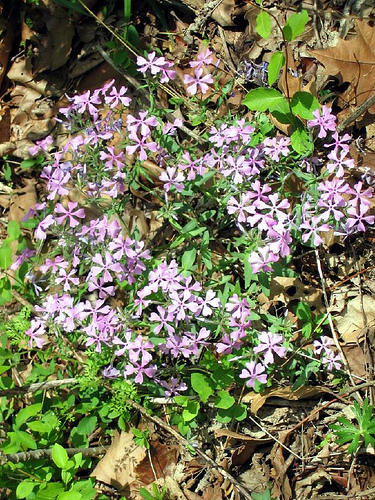
Phlox divaricata, blue phlox
(*photo
credit)
April 23, 2007 The Environmental Costs of Meetings
The Environmental Resource Assessment Service component of
Earthhealing was recently asked to perform an assessment of a large
national meeting for an academic organization with growing
environmental concerns. This forced us to consider the practice of
frequent and distant conferences and other meetings that have
become so prevalent in recent years.
Some of a group's customary business can be handled best by
such gatherings, for these assemblies can produce a synergy that
could not be obtained without physical proximity. But some
meetings could be less frequent or substituted for because land and
air travel takes much fuel. What people often fail to realize is
the resource intensity of frequent meetings. The mentality of
frequent and distant meetings deserves questioning:
* Is the meeting necessary, or can the business be handled by
phone, email or regular mail or conference calling? Sometimes the
question of meetings has to do with a mistaken belief that this is
the most important thing that can be done at this particular time
by attendees. And there are the unspoken social aspects as well.
Unfortunately, those who spread this philosophy of frequent
assembly often do not have enough work to do and make meetings
their excuse for not doing less agreeable desk work.
* Are some of a series of meetings to be avoided and thus the
frequency of such meetings changed from monthly to bimonthly, or
quarterly or semi-annually, or annually to biannually? Regular
meeting-goers seldom look beyond economic costs to the somewhat
less obvious environmental impacts. Instead of conferring by mail
on such a matter as the expense of a meeting, the attendees may
even propose going to extra meetings to discuss the problem.
* Do the sheer numbers attending a given meeting need to be
gathered or could other methods be found to elicit the same
dynamics without physical presence? Teleconferencing?
* How distant are the attendees from each other? Shouldn't
frequency be partly determined by distance? If all are in a small
community and can walk to the meeting place, more frequency is
tolerated. If the attendees come from across the nation or the
world, should not meetings be more rare?
* How open are the meetings? Could not a representative group
go and report back to the others about the results of the
conference? Modern communications allow various degrees of
participation from those present and those at a distance.
* Does the group consider the environmental cost when
calculating the feasibility of a given location? If a conservation
ethic being followed, then the meeting's energy expenditure from
travel would mean that gatherings should take place in a central
place accessible by public transportation.

Asarum canadense, wild ginger
(*photo
credit)
April 24, 2007 Physical Exercise for All
We seek to do and encourage physical exercise on a daily basis
(see Daily Reflections 1/18/05), but one wonders whether that is
enough. Should confirmed couch potatoes who may hurt themselves be
encouraged to exercise? Or are more aggressive programs needed to
further the healthy practice of exercise? This is National TV-
Turnoff Week and a perfect time to think about more imaginative
programs to further America's physical exercise routine.
Family exercises. Parents could enforce "TV-Turnoff Week" and
send the kids outside on these spring days. Some youth refrain
from participative sports and should not be pushed into that
direction -- but other non-competitive individual and family
exercises are possible (hiking, biking, touring of nature areas.
etc.). Not all youth are destined for sports. In addition there
is little exercise by the adults sitting as spectators in stands to
cheer the youngsters. The whole family needs exercise.
Mandatory school exercises. Some students will complain, but
mandatory exercise will help retard obesity among youth, a
condition that could affect them for the rest of their lives. This
is worth the few complaints for the sake of the common good. The
required exercises need never be beyond the endurance of the
youngsters and certain allowances may have to be made for the
physically challenged -- but all can be engaged in some way. The
exercise is known to improve the learning ability of the students.
Senior citizens. All who are at least able should be given an
opportunity to walk about, do arm or leg exercises, and engage in
other lighter forms of physical exercise. Again a mandatory
approach actually works as part of the daily fare and benefits will
touch all in some way.
Office workers. Quite often workers on their feet all day are
doing exercises and are actually exhausted at the end of the day.
A meter can be purchased that can calculate whether one is moving
about two or more miles a day -- and many housewives, secretaries,
clerks, and others fill the bill while hardly realizing it.
However, others seldom move from their desks and are glued to the
computer screen for much of the day. A mandatory work break for
exercise of one half an hour a day may be innovative, but is a good
overall practice in the business and governmental world.
What becomes apparent in the world of rapidly rising
convenience and resulting obesity is that exercise is an imperative
for people, with very few exceptions (someone in traction with
broken bones). Daily exercise should not simply be encouraged; a
little extra push could be made by parents, school administrators,
caregivers and office management. That could go a long way to
improvement of our national health picture. Turning off the TV is
the beginning. What do you do after it is turned off?

Arisaema atrorubens, Jack-in-the-pulpit
(*photo
credit)
April 25, 2007 Conservation Easements
Land is being cluttered through unplanned development in so
many parts of our nation. In many places farming is on the edge,
as pressures mount to turn open space into spatial lawns and
urban development projects. One answer as we move to a more
viable conservation ethic is to promote conservation easements.
The present holders of the land could come to a voluntary
agreement with a non-profit organization or government agency
according to which the property owners limit the activities that
can take place on the property -- and thus limit developmental
use of the land. Easements are recorded with the deed for the
property and are perpetual and thus bind all future owners to
honor non-development of the property. Property owners retain
title to their land, they can sell it when they wish to do so,
and they do not have to give up any rights that they wish to
keep.
Easements may carry financial benefits for the property
owners. If the donor gives the easement or sells it for less
than fair market value to the public agency or private
organization, the difference between fair market value of the
property before granting the easement and fair market value
afterwards can represent a charitable contribution. Furthermore,
local annual property taxes may be reduced, because the easement
means that the value of the land has dropped due to giving up
development rights. These easements may pertain to preserving
land for outdoor recreation, education, protection of wildlife
habitats, or other forms of public benefit.
The recipient of the conservation easement is responsible
for monitoring the easement to see that whoever manages the land
adheres to the terms of the easement, and, if the easement is not
being honored, for bringing the owners into compliance, if
necessary by going to court. Administering easements requires a
lasting commitment of time and money on the part of the agency or
organization and can become a way of sharing the commons with the
larger community of people.
Depending on the type of easement, the land remains in open
space (pasture, woodland, cultivate fields, etc.), which is
attractive and conducive to the quality of life needed by the
community. All benefit from this restraint on development and a
sense of stability returns to the community. All is not subject
to clutter and congestion. The easement becomes a signal to the
community that more of the undeveloped areas could fit into the
green space/undeveloped category, and this gives a local
incentive to other conservation-minded people to make the
easement a legacy for the people who can all benefit from
undeveloped land.

Delphinium tricorne, dwarf larkspur
(*photo
credit)
April 26, 2007 Support Micro Loans
One way to assist the very poor and low-income is to offer
opportunities for these folks to receive micro loans in order
that they may start an enterprise that will furnish a reasonable
livelihood for the family. The micro-loan concept is spreading
among those who do not have much resource to give and yet it is
far better than mere charity, for the entrepreneurial spirit is
potentially thriving only if a catalyst exists to help trigger
the process. Dr. Muhammad Yunus, the founder of the Grameen Bank
in Bangladesh, won the 2006 Noble Prize for Peace by establishing
a system whereby 50 million people have benefited from bank
loans.
The practice of giving micro-loans to lower income people is
part of a campaign to extend business funds for start-up of
independent enterprises. This should benefit people who would
not otherwise be able to break their bonds of indebtedness -- a
form of slavery. These micro-loans are not so much a concession
to the current world economic order as a way to liberate those
virtually enslaved by overwhelming indebtedness. To fail to
spread the financial resources is to allow the current
concentration of money in the hands of large banking operations,
along with oppressive financial conditions.
The periodic freeing of all people from debt will most
likely disrupt this financial system if performed too suddenly.
Micro loans are a far more moderate proposal and have been found
to work in Bangladesh and other so-called developing nations.
Micro-loans allow the small home industry (purchase of basic
materials and equipment) to proceed without extortion caused by
money lenders. It gives people a fresh lease on life -- a true
sense of resurrection and new life.
One such group that has been operating since 1984 is the
Foundation for International Community Assistance (FINCA), which
focuses on providing destitute mothers with small loans to help
them break out of poverty and become financially independent. It
found that nearly half of all impoverished families in the so-
called developing world depend on income generated by women.
FINCA saw that the poor have no collateral and thus do not
qualify for commercial loans. By working through a Village
Banking group people are able to receive a starting loan of fifty
dollars to help with the purchase of basic materials. The
village bank members are fully responsible for their own success.
They choose their investments, disburse and collect all loans,
manage their savings, elect their officials, write their by-laws,
and keep their own books. Such a system generates basic
empowerment. For more information contact:
Foundation for International Community Assistance
1101 14th Street, N.W., 11th Floor
Washington, DC 20005
phone: (202) 682-1510
website:
www.villagebanking.org
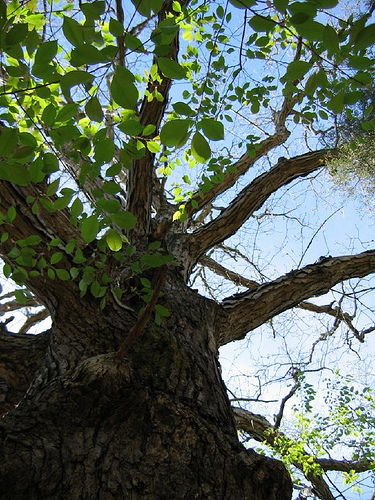
Looking up through the branches of a very old oak /
Franklin Co., KY
(*photo
credit)
April 27, 2007 The Blessings of April Showers
April can be a gentle month of showers and light rain in our
temperate part of the northern hemisphere. What we often forget
is that there are many benefits to showers worth recalling:
Music makers -- April showers are music to our ears. All
know the sweet sound of raindrops splattering on a windshield or
the metal roof of a building. In fact, for most of us who have
not been terrified by floods, this is a pleasant sound that can
induce sleep and comfort.
Renewers of life -- Plants thrive in spring showers that add
the moisture required for growth. Grass and newly sprouting
vegetables especially like these showers at this time of year
when all is tender and just beginning to grow.
Foliage enhancers -- Warm spring showers allow the woodlands
to clothe themselves a little more rapidly while we await the
spurt of May's unfolding that is just around the corner.
Gifts -- For those of us who like to grow things in the
warmer weather, a shower is most often a welcome thing, and thus
we can pause and thank God for the gift of water, a true marvel
to behold that comes in such a gentle manner.
Birdbaths -- It is a pleasure to watch birds preen
themselves in an April shower. They seem to enjoy the free bird
bath and their activity is a pleasure to behold.
Cleaning agents -- The winter roads and countryside have a
way of accumulating slush. The March winds can trigger dusty
conditions in some dry places. We welcome the removal of winter
grime by the showers of April.
Nature's song -- April showers can be heard from a distance
when we are outdoors as they move in our direction. As the
shower comes closer we hear the gentle warning to take cover.
Harbingers of spring -- The sight, sound, taste, feel and
smell of a shower confirms for us who are out in the shower that
spring is before us. We come alive.
Bookmarks of the season -- Somehow spring is the best time
for showers and so their occurrence makes us all the more aware
that we must accommodate the season.
Children's playtime -- When showers occur in warm weather
young folks in swimming suits or regular clothes enjoy cavorting
and dancing in the rain. There is something especially
exhilarating about being in a shower when one does not have to
care about getting cold when wet.
Flower makers -- "April showers bring May flowers."
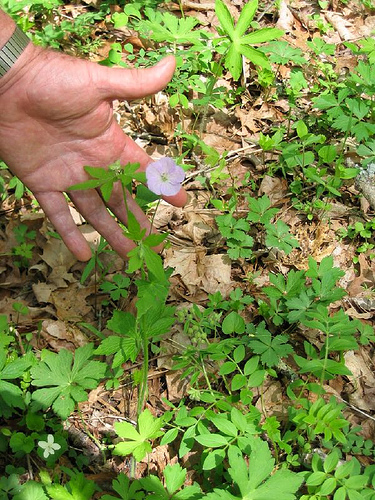
Geranium maculatum, wild geranium / Madison Co., KY
(*photo
credit)
April 28, 2007 The Wild Geranium
April in Kentucky is the month of wild flowers of a wide
variety. The landscape that was so drab only a month before
suddenly comes alive with violet, yellow, orange and red colors
of various hues and combinations. All of us deserve to spend
some time during this narrow space of spring wild flower season
outdoors enjoying the sights and smells.
This happy time of year is reflected as you will note in
the thirty photographs by Janet Powell that accompany this
month's daily reflections. We have moved from weekly to daily
photos, as we concluded that the month of April was the ideal
month to initiate this addition to our program. All the flowers
shown here bloom during this month in some part of our
Commonwealth and in parts beyond.
All of us have wild flower favorites. Perhaps mine is not
the most popular one -- the wild geranium (Geranium maculatum).
I am unsure what leads to the wild geranium's attractiveness,
except that the delicate violet/rose color amid the sea of
greenery brings back memories of springs past. Some regard this
cousin of the cultivated geranium as unattractive when single,
whereas a field of them is worthy of special notice. I disagree,
and part of this may be the geranium's presence in accessible
places in well drained soil; this is quite often along underused
compacted walkways and roadbeds. Thus you do not have to go to
wilderness places to find the wild geranium.
Maybe it is the name for the cultivated geranium in window
boxes remind of our European ancestry, and the smell of that
plant always seems so distinctive, clean and refreshing. It may
be that a few leaves of the wild geranium can be put in salads
just as those of violets and dandelion. I think it is the entire
collection of factors that makes me like the wild geranium along
with the heartiness of this flower that come compare to that of
violets and dandelions -- but one must add that the wild geranium
cannot tolerate continued disturbance such as lawn mowing.
Whatever the hidden reasons, favorites do not distract from the
varied beauty of all the wildflowers of this season. The trees
will soon achieve full foliage and we will have to await another
year to appreciate this beauty again.
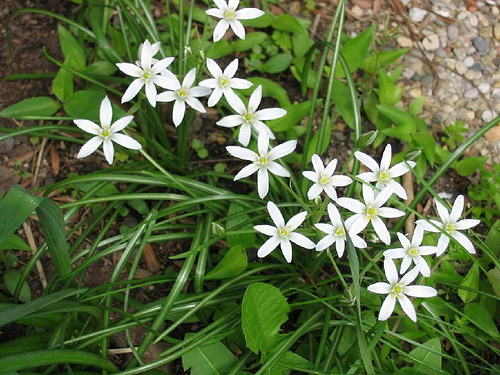
Ornithogalum umbellatum, star of Bethlehem / Fayette
Co., KY
(*photo
credit)
April 29, 2007 Shepherd Sunday and Sun Day
These are the people who have been through the great
persecution... (Revelation 7: 14)
Today we strive to combine Shepherd Sunday with Sun Day. In
Shepherd Sunday we recall that we are followers of Christ who
goes ahead of us: he calls us each by name; he cares for us
tenderly and lovingly; he is willing and lays down his life for
us; he is the true shepherd. But he is also the light of the
world; what he does as light is what we are called to do in
enlightening others, to catalyze them to action, to lead the way,
and to warm the hearts. Thus two concepts merge into one --
shepherd and light, the one who comes through the darkness of
Calvary and into the resurrected light, and the one who shows us
how to enlighten the troubled world.
As followers of Christ, we are sheep who trust in God's
mercy and faithfulness. We are sheep of the divine flock (Psalm
100). But we must do more than just trust; we are willing to
enter the struggle, which means we formally reject the
materialism that envelops this world. We become counter-cultural
and are willing to be different. Just as Jesus, the Good
Shepherd is willing to lay down his life for us, we, in turn, are
willing to be of service to and for others on this Earth --
plants, animals and human beings within a community of all
beings. Jesus is a lamb -- but we hardly call our athletic teams
lambs who are meek, loving, and near at hand to help others.
The qualities we are to exhibit are those of the Good
Shepherd, but most especially those of being willing to sacrifice
for others. Today, we can help overcome a dispirited world
through a closeness to Christ. We profess our willingness to
help others see that there is life beyond the material world that
entices us in every way. Part of this counter-cultural attitude
is to be anti-competitive, to become lambs rather than wildcats,
to be part of a flock living together in peace. Part of this is
discovering a way of building a community of peace and justice.
Sheep are hardly known to make profound changes on this
Earth, nor are shepherds. But the flocks working together can
make a difference. We proclaim firmly and gently that we cannot
continue to be half haves and half have-nots; we cannot continue
the aggressive competitive culture with its massive salaries for
the upper echelon and its lack of health care for the lower end
of the wage scale. What is needed is something new, a new
society that is in the making, and yet most people are afraid to
say it. Just as the sun gives light, we become God's renewable
resource. We are committed to do no harm to the environment by
our actions; we grow in new life in a divine photosynthetic
process; we lead others to overcome the darkness of materialism
and to be led by the light of faith. Shepherding takes into
consideration Sun Day for we are called to light and to bring
others along on this journey of faith.

Rainbow against darkened early evening sky / Red River
Gorge, KY
(*photo
credit)
April 30, 2007 Rainbows, Luck and Gambling for a Better
World
Rainbows come rarely and when they do we regard the
phenomenon as momentary good luck. We run the risk of missing
rainbows and yet we always take far larger risks -- whether the
car will go another year, whether we will achieve the assignment
on which we are now engaged. We take chances; we ride on our
luck; and we seem to enjoy uncertainties to some degree. As we
approach the Kentucky Derby weekend and the annual bets on some
horse we know very little about, let's take another look at the
urge, temptation, art or habit of taking risks and gambling.
One of the greatest conspiracies of the current economic
system is the notion that one can become rich like a rare but
highly publicized Grand Lotto winner somewhere in this vast land,
who just won tens of millions. The winner seems so ordinary and
so much like you and me. Maybe that luck could happen to us.
Little do we realize that the chances of being struck by
lightning are greater than those of being that grand Lotto
winner. So each week after receiving the pay check, some unwise
and day-dreaming working friends peel off five, ten and twenty
dollars on the next round of gambling -- and little of that money
goes to state operations, and a major portion to gambling bosses.
Deception reigns supreme. Why can't people realize this,
except that they live in a world of semi-fiction? And one of
these fictions is that one can become rich with almost no effort.
Fiction looms bigger than reality and dreams crowd out the
harshness of ordinary work. But gambling is not the only spice
that gives meaning to life, even though it is wildly popular and
leads to an addiction that can ruin even the most wealthy.
Gambling dehumanizes and makes one the ward of the state,
complacent in not realizing that life is a far more serious
gamble, some of the odds of which could be changed by human
planned actions. Gambling makes the capitalist unrealistic dream
of wealth stay in the mind and crowds out resourcefulness and
utilization of limited resources. Shouldn't gambling in all its
forms be taxed all the more severely? One problem with this is
that the lower income folks suffer most from this regressive tax,
for many in these ranks are governed by a craving for quick
wealth. The tax burden falls heavily on the poorer folks.
How about returning to the realistic dreams that we
experience? Take a chance that we could develop a more
responsive political system and channel efforts in the direction
of political action. Put time and resources into changing the
system so that wealth is not redistributed from many poor people
to one lucky individual who suddenly gets rich. Invest time and
energy and even money into changes through which all can gain the
basics of life. Let's gamble to get winners who can change the
system. Let's make this a win/win situation wherein the public
benefits. Chance and risk take on new meaning as we seek to
change the global environment for the better. We risk not
succeeding but it is worth a try.

Blue violet, Viola sororia
Sunrise Ridge, Stanton Kentucky
(photo: Marge Para)
|
|